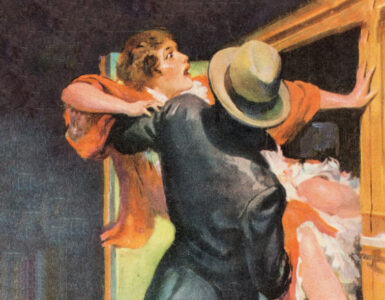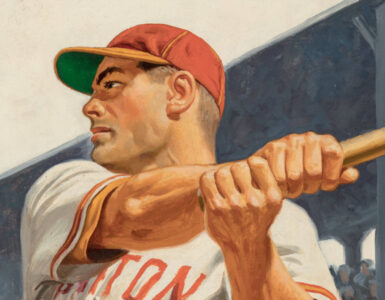Fifty years ago, there were no organized gatherings specifically geared toward pulp fiction and the magazines in which it appeared. That all changed when Ed Kessell, Earl Kussman, and Nils Hardin founded Pulpcon in 1972. This year we salute the fiftieth anniversary of that first pulp con — the convention now called PulpFest.
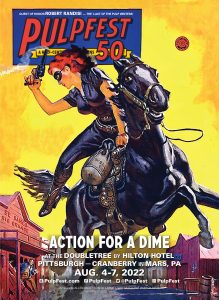
The year was 1981. I was 16 years old, obsessed with Doc Savage, and just clever enough to persuade the likes of Will Murray, Frank Hamilton, Bob Sampson, and others to contribute to a yet-to-be-published fanzine entitled The Savage Society of Bronze.
I was also just lucky enough to convince Al Tonik, Shelby Peck, Link Hullar, Gary Goodman, Nick Carr, and Dafydd Neal & Allyson Dyar to add their talents as part of the “others” category. Aside from the obvious pulp expertise inherent in that group, Al Tonik was just kind enough to take a fellow Philadelphian under his wing. The pulp gods intervened, and Al introduced me not only to the local burgeoning pulp community but also to the mythical event known as Pulpcon, as it was dubbed then. By happenstance, Pulpcon 13 was just across the river in Cherry Hill, New Jersey.
This association with Pulpcon and Al Tonik led to meeting the two Walters forever enshrined in the pulp pantheon — Walter Gibson and Walter Baumhofer. Gibson signed my copy of The Shadow Scrapbook — co-written by Gibson and Anthony Tollin — the night The Shadow made his startling appearance at the signing. Baumhofer signed several of my Doc Savage pulps, kindly adding “my friend” to his personalized inscription. I still remember Al advising me to buy as many of the early Doc Savage pulps I could afford for Walter to sign, as prescient a suggestion if there ever was one. Frank Hamilton was equally kind enough to make the introduction, and my inscribed copy of “Pirate of the Pacific” is still the treasure of my collection.
As wonderful as those memories are (and they are quite wonderful), it was the friendships forged at these and later PulpFests that I will treasure most, even as they’ve unevenly spanned the decades since. Sadly, too many of the names mentioned above are no longer with us, as well as Pulpcon/PulpFest stalwarts such as Howard Hopkins and Chuck Juzek.
But with an event like PulpFest, there are always new friends to be found, and found them I have. Passionate pulp aficionados to chat away the evening. Fellow collectors discussing our latest hauls. Pulp art enthusiasts discussing what original art might still survive. And writers sharing tidbits of their latest works. Sometimes in Cherry Hill, New Jersey. Sometimes in Dayton, Ohio. And now in Pittsburgh, Pennsylvania.
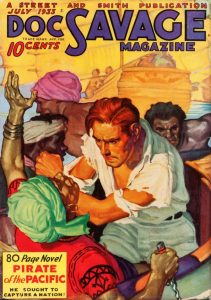 To answer the question, “Why PulpFest?” It’s more than just the dealer’s room, though that might be the best around. It’s more than just the panels, though those might be the most compelling. If you ask me (and you did), it’s about the unforgettable memories. It’s about an unsurpassed communal pulp experience. And it’s about seeing old friends, making new friends, and most importantly, making new unforgettable memories.
To answer the question, “Why PulpFest?” It’s more than just the dealer’s room, though that might be the best around. It’s more than just the panels, though those might be the most compelling. If you ask me (and you did), it’s about the unforgettable memories. It’s about an unsurpassed communal pulp experience. And it’s about seeing old friends, making new friends, and most importantly, making new unforgettable memories.
So if you’re reading this post and you’re on the fence about attending PulpFest this year, take a page from my book and plan your next adventure for this August. And if you do, make sure to pull me aside, say hi, and who knows, maybe, to mix genres, like Rick Blaine and Captain Louis Renault, this will be the beginning of a beautiful friendship.
We hope you’ll join us to celebrate “A Half-Century of Pulp Cons” at PulpFest 50. It will take place from August 4 – 7 at the DoubleTree by Hilton Hotel Pittsburgh – Cranberry in Mars, PA. You can become a member of the convention by clicking the Registration button on our website. If you need lodging, you can also book a room on our site. Remember, you must book your room by 11:59 PM on Tuesday, July 12, to get the special convention rate.
If you would like to register as a dealer at this year’s PulpFest, we’ve run out of tables. Please contact Jack Cullers ASAP to be added to our waiting list. You can reach him at jassways@woh.rr.com or jack@pulpfest.com.
Jennifer DiGiacomo is a digital technologist, having created the first online reality series (AOL’s The Startup), and a writer, winning the Silver Telly Award for The P.O.B. Conspiracy. More recently, she worked on Breaking Bad and Better Call Saul for AMC, and the digital comic strip Cerebus in Hell? with Dave Sim. From 1982 to 1985, Jennifer was the publisher of The Savage Society of Bronze, a Doc Savage fanzine. Currently, she resides in New York City and has several more writing and publishing efforts planned.
Our postcard image has been adapted by PulpFest advertising director William Lampkin from Allen Anderson’s cover for the March 1950 issue of Lariat Story Magazine. The Fiction House pulp debuted in February 1925 as True Adventures, a magazine that featured supposedly true stories of adventure. After seven issues under that title, the magazine was rechristened as The Lariat Story Magazine.
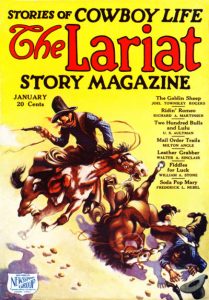 Inspired by the tremendous success of Street & Smith’s Western Story Magazine, the new Fiction House pulp featured “Stories of Cowboy Life.” After dropping “The” from its title in its February 1926 number, Lariat Story Magazine began to run “Cowboy-Life Stories” with its March issue. In 1938, it would start featuring “Cowboy-Life Romances.” Pictured here is the last issue of The Lariat Story Magazine — dated January 1926 — with cover art by Elliott Dold.
Inspired by the tremendous success of Street & Smith’s Western Story Magazine, the new Fiction House pulp featured “Stories of Cowboy Life.” After dropping “The” from its title in its February 1926 number, Lariat Story Magazine began to run “Cowboy-Life Stories” with its March issue. In 1938, it would start featuring “Cowboy-Life Romances.” Pictured here is the last issue of The Lariat Story Magazine — dated January 1926 — with cover art by Elliott Dold.
The “star” of the early years of Lariat Story Magazine was Walter J. Coburn, whom Fiction House billed as “The Cowboy Author.” Growing up on a working ranch in Montana, Walt Coburn — as he later became known — knew what he was writing about. The first issue of Lariat — dated August 1925 — featured Coburn’s “Riders of the Purple,” surely a play on the popular western writer Zane Grey’s “Riders of the Purple Sage.” Cowboy artist Will James illustrated the first issue.
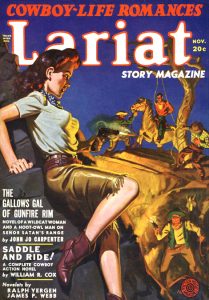 Although originally a celebration of the American cowboy, its 1940s issues — when the magazine began to explore other periods of the American frontier — are thought to be the pulp’s “Golden Age.” During the decade, Tom Blackburn, Frank Bonham, William R. Cox, Dan Cushman, D. B. Newton, Wayne Overholser, Les Savage, Jr., and other writers contributed many wonderful stories. At the same time, artists Allen Anderson and Norman Saunders contributed countless fabulous covers.
Although originally a celebration of the American cowboy, its 1940s issues — when the magazine began to explore other periods of the American frontier — are thought to be the pulp’s “Golden Age.” During the decade, Tom Blackburn, Frank Bonham, William R. Cox, Dan Cushman, D. B. Newton, Wayne Overholser, Les Savage, Jr., and other writers contributed many wonderful stories. At the same time, artists Allen Anderson and Norman Saunders contributed countless fabulous covers.
Including the seven issues of True Adventure, Lariat Story Magazine would run for 194 issues, its final number dated Spring 1951.
Join pulpfest.com on July 27 when Bob Deis and Wyatt Doyle, publishers of the Men’s Adventure Library, answer the question, “Why PulpFest?”


